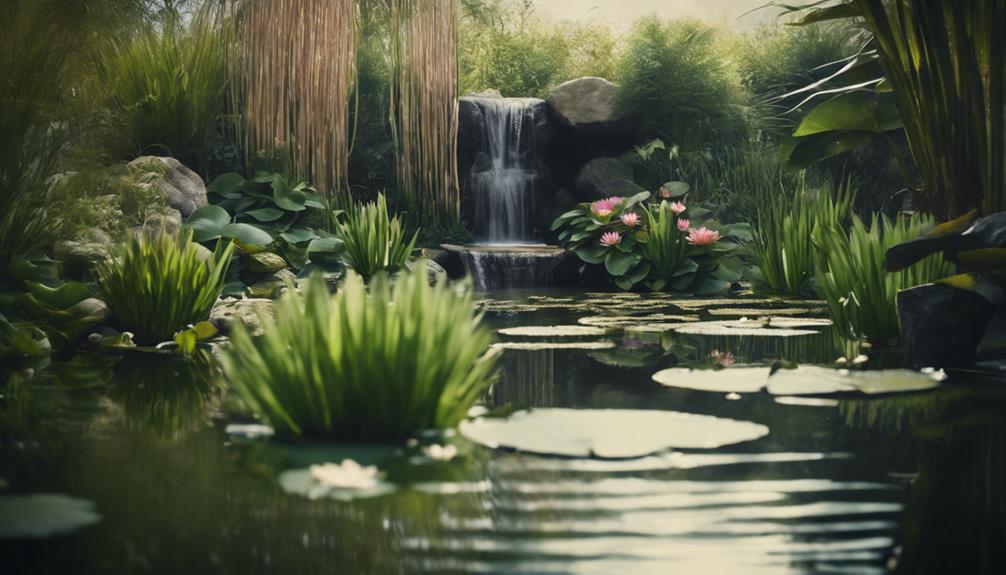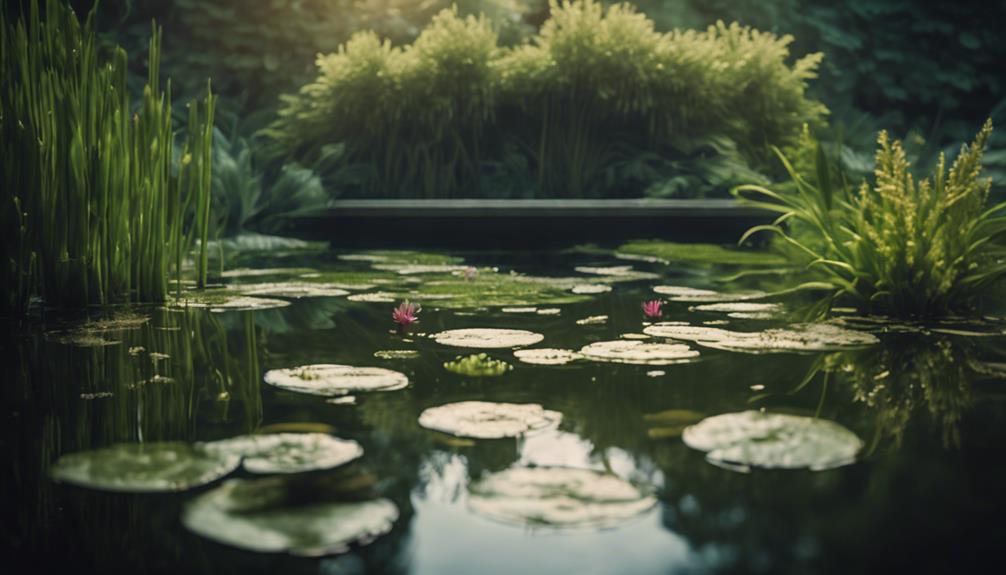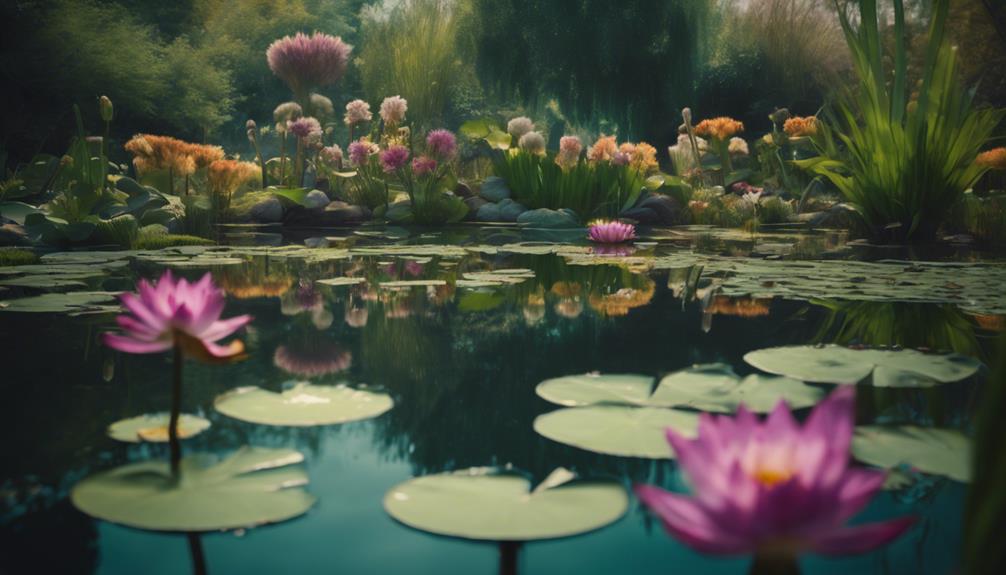You can incorporate oxygenating plants like Cabomba, Elodea, and Hornwort into your garden pond to naturally purify the water and create a healthier environment for aquatic life. These plants absorb excess nutrients, reduce algae growth, and support beneficial microorganisms that break down organic matter. By controlling algae growth, they create a more balanced and sustainable environment. You'll also find that Anacharis, water wisteria, and java moss are effective at removing ammonia, nitrite, and nitrate from the water. As you explore the world of aquatic plants, you'll discover how to create a thriving ecosystem that's full of life and energy.
Table of Contents
Key Takeaways
- Cabomba, elodea, and hornwort are top plants for water purification, effectively removing impurities and excess nutrients from the water.
- Anacharis, water wisteria, and java moss are effective at removing ammonia, nitrite, and nitrate from the water, improving water quality.
- Oxygenating plants like Hornwort and Cabomba absorb nutrients and pollutants from the water, reducing algae growth and maintaining ideal water conditions.
- Water Lettuce, a floating plant, provides shade, absorbs excess nutrients, and provides a habitat for beneficial microorganisms, contributing to water purification.
- Incorporating a mix of submerged, marginal, and floating plants maintains a balanced ecosystem in the pond, ensuring crystal-clear water and a thriving aquatic environment.
Oxygenating Pond Plants Explained
As you explore the world of water purification using plants, you'll discover that oxygenating pond plants play a vital role in maintaining a healthy aquatic ecosystem.
These plants are submerged in the water, releasing oxygen as a byproduct of photosynthesis. This oxygenation process benefits the entire ecosystem, as it supports the growth of beneficial microorganisms that break down organic matter.
In turn, this helps to reduce the accumulation of algae, which can cloud water clarity and deplete oxygen levels. By controlling algae growth, oxygenating pond plants maintain ideal water conditions for aquatic life to thrive.
Additionally, they absorb excess nutrients, further preventing algae blooms. As a result, your pond's water clarity improves, creating a more balanced and sustainable environment.
Top Plants for Water Purification
You'll want to incorporate a diverse range of plants into your water purification system, including species like cabomba, elodea, and hornwort, which have proven track records of effectively removing impurities and excess nutrients from the water.
These aquatic plants are known to improve the water quality by absorbing excess nutrients, heavy metals, and other pollutants. As a result, they create a healthier environment for your pond's ecosystem.
Other top plants for water purification include anacharis, water wisteria, and java moss.
These pond plants are highly effective at removing ammonia, nitrite, and nitrate from the water, making them ideal for maintaining a balanced ecosystem.
By incorporating these plants into your pond, you'll be able to reduce the need for chemical treatments and create a more natural, sustainable environment.
Natural Filtration Methods

Your pond's ecosystem relies on natural filtration methods to break down organic matter and remove impurities, and incorporating these processes into your water purification system can substantially improve water quality.
By mimicking nature's own filtering mechanisms, you can create a balanced and thriving environment for your plants and aquatic life.
One key aspect of natural filtration is the process of sedimentation, where heavier particles sink to the bottom of the pond, allowing clear water to rise to the surface.
Another important mechanism is biological filtration, where beneficial bacteria and microorganisms convert ammonia and other toxins into harmless compounds.
By incorporating plants into your natural filtration system, you can enhance these processes and create a clear and healthy pond ecosystem.
Beneficial Aquatic Plant Species
By incorporating specific aquatic plant species into your pond's ecosystem, you can substantially enhance the natural filtration processes that occur within it.
Submerged plants, for instance, are incredibly effective at absorbing nutrients and pollutants from the water. These plants, such as Hornwort and Cabomba, have adapted to thrive in aquatic environments and can absorb excess nutrients, reducing the growth of algae and keeping your pond's water clean.
Water Lettuce, a floating plant, is another excellent choice for purifying water. It has large leaves that provide shade, reducing algae growth, and its roots absorb excess nutrients from the water.
Additionally, Water Lettuce provides a habitat for beneficial microorganisms that break down organic matter, further contributing to the purification process.
By introducing these beneficial aquatic plant species into your pond, you'll create a balanced ecosystem where plants and microorganisms work together to maintain crystal-clear water.
With the right plant species, you can enjoy a thriving, healthy pond that requires minimal maintenance.
Maintaining a Balanced Ecosystem

Incorporating a mix of submerged, marginal, and floating plants that work together to remove excess nutrients, toxins, and pollutants from the water is key to maintaining a balanced ecosystem in your pond.
By selecting a diverse range of plants suitable for your pond's size, depth, and water conditions, you can create a thriving aquatic environment.
Maintain a balanced ecosystem by maintaining ideal stocking levels to prevent overcrowding and stress on the ecosystem.
Regularly prune and monitor plant growth to prevent the buildup of organic matter and promote new growth.
Select plants that absorb excess nutrients, such as Anacharis and Hornwort, to maintain healthy water.
Monitor water conditions and adjust plant growth accordingly to prevent the buildup of toxins and pollutants.
Create a self-sustaining ecosystem by incorporating a mix of plants that work together to maintain clear water and a healthy pond environment.
Frequently Asked Questions
Do Plants Help Clear Pond Water?
As you tend to your pond, you'll notice that plants don't just enhance pond aesthetics, they also improve water quality by absorbing excess nutrients, and you'll reap the plant benefits of a healthier, more balanced ecosystem.
How Do I Keep My Pond Water Clear Naturally?
You're a million miles ahead in keeping your pond water crystal clear naturally! Focus on pond aeration, water circulation, and natural sedimentation to create a thriving ecosystem, and prune your plants regularly to prevent organic matter buildup.
What Is the Best Plant for Filtering Water?
When selecting the best plant for filtering water, you'll find Aquatic Nurseries recommend Water Lilies for their efficient nutrient uptake, complementing Filtration Systems to maintain superior water quality, and creating a thriving ecosystem you can proudly call your own.
Which Plants Are Natural Purifiers of Water?
You'll find that certain plants, like cattails and duckweed, are natural purifiers of water, playing a vital role in aquatic ecology and water remediation by maintaining ecosystem balance, and they're perfect for your garden pond too!
Conclusion
As you gaze out at your thriving garden pond, remember that it's not just a pretty face – it's a delicate ecosystem that needs your care.
Just as a master chef balances flavors, you must balance your pond's water quality with the right mix of plants.
By incorporating oxygenating plants, natural filtration methods, and beneficial aquatic species, you'll create a harmonious symphony that keeps your water pure and clear, just like a maestro conducting an orchestra.

